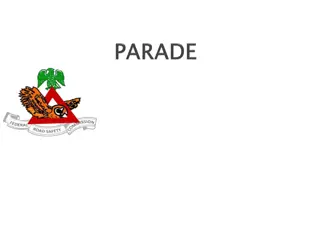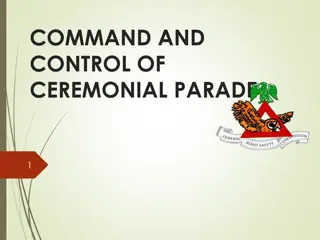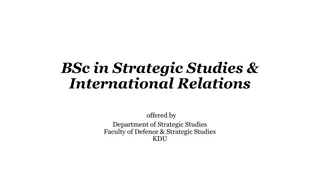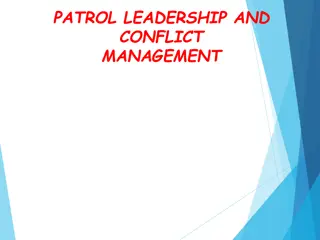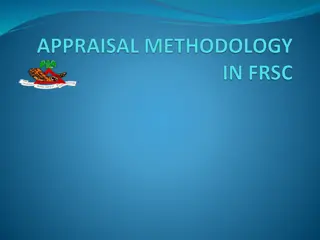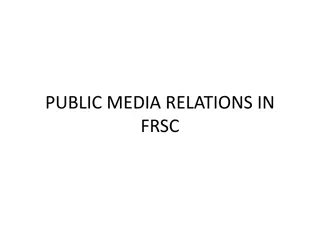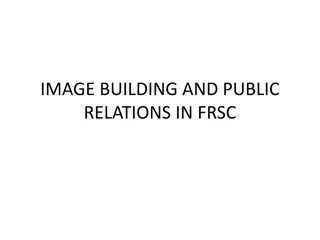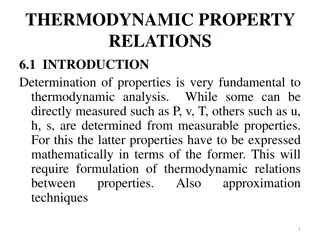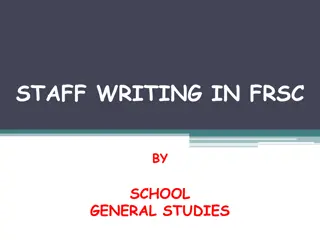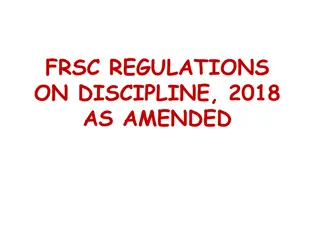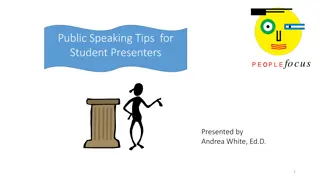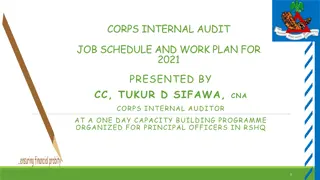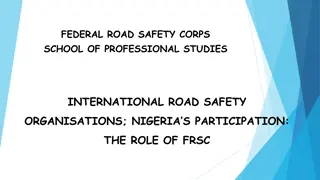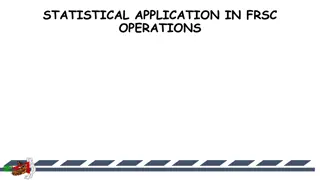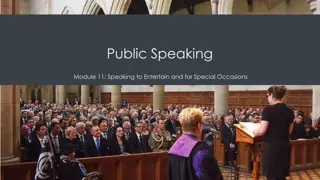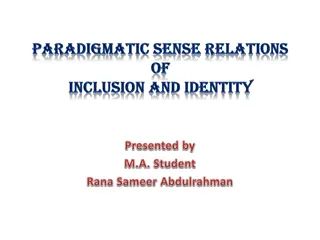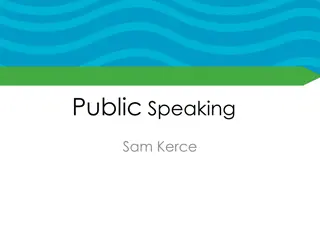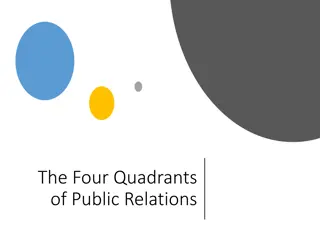Mastering the Art of Public Speaking and Public Relations in FRSC
The Federal Road Safety Corps (FRSC) aims to address road traffic crashes through attitudinal change and safety consciousness. This lecture focuses on teaching officers the techniques of public speaking, emphasizing qualities of a good speech and speaker. Participants will learn to deliver impactful speeches, understand public speaking basics, leadership qualities, speech types, and public relations in FRSC, fostering effective communication and promoting safety awareness.
Download Presentation

Please find below an Image/Link to download the presentation.
The content on the website is provided AS IS for your information and personal use only. It may not be sold, licensed, or shared on other websites without obtaining consent from the author. Download presentation by click this link. If you encounter any issues during the download, it is possible that the publisher has removed the file from their server.
E N D
Presentation Transcript
ANd9GcT_Ky6-32M72wITEVRJrjiLTgxVli3fzxLp3E-UYH0OUVYcuGOfPXlfW_sANd9GcT_Ky6-32M72wITEVRJrjiLTgxVli3fzxLp3E-UYH0OUVYcuGOfPXlfW_s THE ART OF PUBLIC SPEAKING AND PUBLIC/MEDIA RELATIONS IN FRSC
INTRODUCTION The Federal Road Safety Corps as an agency came into being as a result of a great social problem. The problem was road traffic crashes and the attendant misery that it brings to people. Apart from taking lives, it maims many and renders them unproductive and dependant on others for survival.
CONTD It is a settled fact that the human factor is the most potent factor responsible for road crashes. Therefore, to reduce road traffic crashes to the barest possible minimum, there is a need for attitudinal change towards road usage in the society.
CONTD This can be only achieved through persistent, interesting, scholarly but informative, clear, concise, and corrective preaching of the message of safety consciousness in every available forum. Such forums include, but not limited to; Motor Park rallies, television talk shows, radio programmes, interviews, etc.
AIM The aim of this lecture is to teach officers the art and technique of public speaking.
OBJECTIVES At the end of this lecture, participants should be able to: Deliver a speech Explain the basics of public speaking List the qualities of a good leader Discuss various types of speech Discuss public relations in FRSC
QUALITIES OF A GOOD SPEECH Any good speech must have certain qualities that ensure the fulfillment of its purpose And that purpose is to convey ideas or information from the speaker to the audience. As such, the speech has to be: simple, clear, concise, forceful, and pleasing.
QUALITIES OF A GOOD SPEAKER According to George Kaitholil, a good speaker should have ELOQUENCE, and this is made up of the following: Earnestness Observation Quick wittedness Useful intention
CONTD Enthusiasm Confidence in self Empathy
DOS AND DONTS OF A GOOD SPEAKER. Be audience-oriented, know the level of education of your listeners, their interest, views and sensibilities and this will help you to know how best to put your ideas across to them. Be a good listener, when you listen to other speakers you learn more and become a better speaker.
CONTD Listen to yourself as you speak- The volumes of your voice, the speed of talk, the inflection, hesitations and punctuations are very important. You must have a deep understanding of the topic you are speaking about- carry out adequate research on the topic and ensure you have all the facts and figures at your finger tips.
CONTD Make conscientious effort to achieve the optimum response. Take responsibilities for what you say Know your limitations, and be honest enough to acknowledge them. Do not be over confident, and do not put on airs.
TYPES OF SPEECHES There can be as many kinds of speeches, as there are speakers, audience, and occasions. Some examples are: Lecture Narrative or descriptive speech Sermon
CONTD Political speech Funeral oration Vote of Thanks (Speech) Closing speech Valedictory speech Toast Debate speech
THE PROCEDURE FOR AN EFFECTIVE SPEECH DELIVERY: It is a well accepted fact that practice makes perfect. For you to successfully deliver a speech the following steps should be taken: Plan the speech Prepare the speech Practice the speech Perform the speech
HOW TO START You must conquer stage fright. Once you have mastered your speech through proper planning and rehearsal, there is no reason why you should fidget:
ADDRESS OR SALUTATION When you are called upon to give your speech, you have to walk briskly and gracefully to the podium looking straight with a smile and an air of importance and confidence around you.
THE OPENING SENTENCE The opening words should elicit the goodwill of the listeners and make them benevolent towards you. The speech should therefore be made up of: Greeting Opening sentence Introduction Main Body Conclusion
HOW TO STOP The conclusion should be well planned to make an impact. It should be a well directed effort to impress on the audience, the views and sentiments you have already expressed.
HOW LONG TO SPEAK According to la Rochefoucauld, true eloquence consist in saying all that is necessary, and nothing but necessary. Therefore while delivering your speech, keep the KISS acronym in mind i.e. Keep It Short and Simple Not by mouth alone
USE OF GESTURES Gestures are motions of the body meant to add grace and expression to speech. They are effective natural aids a speaker can use in expressing himself.
WHAT ARE PUBLIC RELATIONS Public Relations are the practice of managing the spread of information between an individual or an organization and the public. It is the strategic communication process that builds mutual beneficial relationship between organizations and their publics. Public Relations contribute to the way an organization is perceived. This, can be done by influencing the media and maintaining relationships wit stakeholders
PUBLIC/ MEDIA RELATIONS IN FRSC The FRSC as a traffic law enforcement agency had a lot of enlightenment to do at the beginning of its existence and now. The Corps engage the use of the different types of media e.g the radio, television, newspapers, road shows, motor park rallies, conferences, workshops and worship centers. PE office is saddled with this responsibility, even when an average FRSC staff is considered PR man for FRSC
FRSC OFFICERS AND THE MEDIA Officers of the Corps like other public servants, are not allowed to talk to the press without the necessary clearance or authority to do so. Officers are however appointed and trained to handle the information flow of the Corps It is common knowledge that as the press can help to enhance the image of an organization, they can also do the opposite through negative publicity.
COMMON PRESS INFORMATION The number of death and injuries during a Road Traffic Crash The number of crashes in an environment over a period of time The identities of crash victims The ownership of the vehicles involved in the crashes
NON-CLASSIFIED INFORMATION Information from FRSC official website or official documents available to the public are not considered as classified information. They can be released to the public who may need them Information about the duties of the Corps or information contained in the Highway Code, FRSC Establishment Act and National Road Traffic Regulation are examples of such non-classified information
CONCLUSION The task of keeping members of the public abreast with Road Safety Programmes can be fulfilled if FRSC staff are knowledgeable in the art of public speaking and public relations. By the knowledge, we can serve as good ambassadors of the Corps as we articulate our speech delivery and public relations efforts. This will, no doubt sustain the hard-earned positive public image of the Corps Thank you for listening and God bless you




